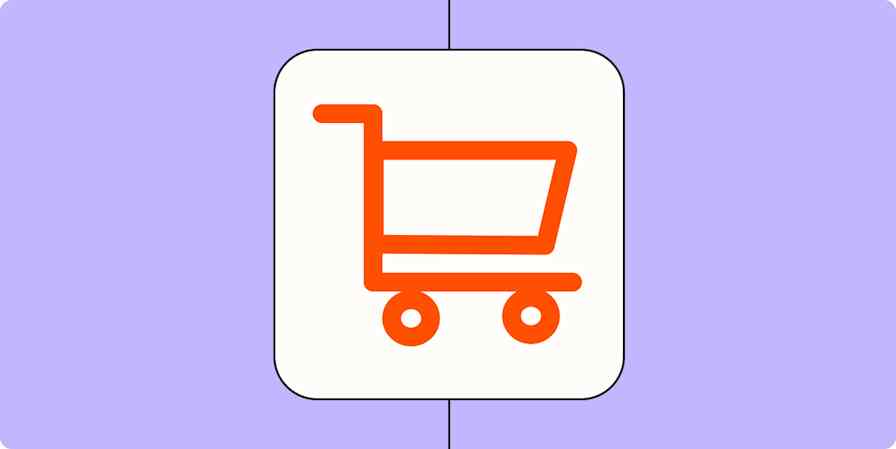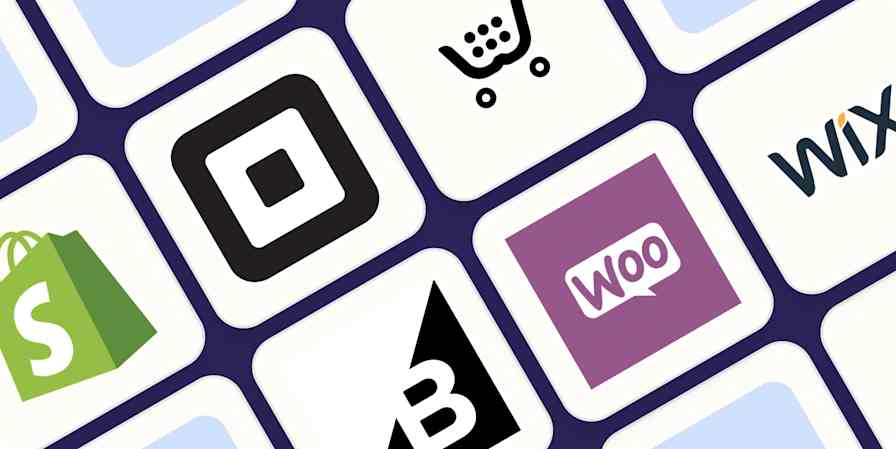As a child of the 2000s, I have firsthand horror stories about what it used to take to make even the most rudimentary website. I grappled with (and lost to) dinosaurs like Macromedia Dreamweaver, and I remember knowing with certainty that I was never going to become a web creator. But today, the hardest part of building a website isn't the construction itself—it's choosing the platform to build it with.
Two of the most popular and powerful drag-and-drop website builders, particularly for eCommerce sellers, are Shopify and Squarespace. After spending time developing test sites with both platforms, I put together this guide to help you determine which website builder best fits your needs.
Table of contents:
For marketing and sales, Shopify prioritizes functionality while Squarespace prioritizes design
Squarespace's pricing is accessible to a wider range of users
For AI, Shopify takes a product-centric approach while Squarespace takes a design-centric approach
Shopify vs. Squarespace at a glance
Let's just call a spade a spade: if you're considering Shopify or Squarespace, the first thing you should know is that they're designed for different things. Shopify is designed for eCommerce sellers to create functional online storefronts, while Squarespace is more of a general-purpose website builder that can also be used for selling.
| Shopify | Squarespace |
|---|---|---|
Pricing | ⭐⭐⭐ Basic ($29/month), Shopify ($79/month), Advanced ($299/month), Plus ($2,300/month) | ⭐⭐⭐⭐ Basic($16/month), Core ($23/month), Plus ($39/month), Advanced ($99/month) |
eCommerce capabilities | ⭐⭐⭐⭐⭐ Built for eCommerce from the ground up; has everything you could possibly need for eCommerce | ⭐⭐⭐⭐ If you're on a high-level plan, you'll get a comprehensive suite of eCommerce tools, but Shopify can't really be beat |
Content management | ⭐⭐⭐ Content management isn't the intended strength of this platform, but it does give users adequate tools to produce content with the help of some of its many integrations | ⭐⭐⭐⭐ Squarespace is content-ready out of the box with its striking templates, user-friendly coding capabilities, and intuitive interface; it just doesn't come with many options for supplementary marketing and SEO integrations |
Design | ⭐⭐⭐ Ample tools to create a professional store and site, but fewer templates and less polish than Squarespace | ⭐⭐⭐⭐⭐ Huge template library, advanced product display options, and additional apps for creating high-quality visual content |
Apps and integrations | ⭐⭐⭐⭐⭐ Massive app marketplace with thousands of sales, marketing, fulfillment, store management, and accounting integrations; integrates with Zapier | ⭐⭐⭐⭐ Integrates with a handful of platforms and offers a short list of extensions, but nowhere near as robust as Shopify's offerings; allows custom-coded integrations; integrates with Zapier |
Ease of use | ⭐⭐⭐⭐ While a robust platform, Shopify's initial setup can be more complex for those new to eCommerce | ⭐⭐⭐⭐⭐ Very beginner-friendly website builder with a drag-and-drop interface |
SEO capabilities | ⭐⭐⭐⭐ Offers some built-in SEO features and a vast app store for more advanced optimization | ⭐⭐⭐⭐ Provides built-in SEO tools, including AI assistance for metadata |
AI features | ⭐⭐⭐⭐ Robust and growing set of AI features through Shopify Magic and Sidekick, focused on eCommerce tasks | ⭐⭐⭐⭐ Design Intelligence and Blueprint AI offer AI assistance with website design, content creation, branding, and SEO |
Squarespace is easier to use with better design options
For a while, Squarespace had a major edge in the design department, but Shopify has gained some ground. Both platforms utilize a no-code, block-based page editor that's easy to set up and edit, and each has well over 100 premade templates to choose from. (Though only a handful of Shopify's templates are free to use.)

But I'd argue that Squarespace still has a better interface with a more attractive site design. I found that the process to add products was almost identical for both platforms, but Squarespace's interface is much more responsive (and prettier) than Shopify's. You can set up beautifully detailed pages for each product, add zoom or lightbox functions for photo clicks, and even upload 360° turntable images for users to rotate.

If you're a serious seller running a large-scale operation, the visual enhancements that Squarespace offers probably won't be worth sacrificing access to Shopify's more advanced eCommerce tools. But smaller businesses and solo sellers may find the trade-off worthwhile.
Despite its advanced design options, Squarespace still has great plug-and-play functionality. Its Blueprint AI tool can even generate a custom template based on just a few words about your business. That's just to say: don't let its pretty face intimidate you.
Shopify scales better for eCommerce
Both Shopify and Squarespace provide all of the tools you need to run an eCommerce store, but Shopify provides the tools you need to run one really well. Shopify shines in areas that make clear that it was built by people who know what it takes to do eCommerce.
Sales: From your Shopify home base, you can integrate directly with other sales channels and sell via Facebook Marketplace, Instagram Ads, TikTok Ads, and even Amazon and Walmart.
Payments: Shopify works with a long list of payment gateways, including the usual suspects like Stripe, Apple Pay, and PayPal, pay-later platforms like Affirm and Klarna, and even international and crypto-based payment systems. Squarespace, on the other hand, only works with credit/debit cards and a few payment processors like PayPal, Stripe, Square, and Apple Pay—though it does make it easier to sell subscriptions natively, while Shopify requires dedicated apps.
Shipping: With direct USPS, UPS, DHL, and dropshipping integrations, Shopify allows sellers to calculate carrier rates, print labels, and take advantage of major shipping discounts all within the platform. Squarespace's basic packages have enough of this functionality to satisfy lower-volume sellers, but they're not as scalable.
In-person selling: Shopify has its own point-of-sale system with transaction rates that are lower than what you get with Squarespace (if you upgrade to a Retail plan), which only offers point-of-sale capabilities via Square.

These differences probably won't matter quite as much to those who are just starting out or who are running a smaller, more basic business on the side; it's primarily those who are aiming to scale an eCommerce business who will really lean heavily on Shopify's additional features and tools.
Shopify has more integrations
There's not much competition here—when it comes to integrations, Shopify's got the goods to help you sell yours.
Shopify's app store runs several thousand apps deep and includes everything from social sales platforms and loyalty programs to customer experience products and dropshipping tools.

Squarespace has expanded its integrations and extensions, but its offerings still don't come close to Shopify's. Its official integrations number in the dozens, further supplemented by another few dozen third-party extensions.
A lot of the major players are all there, like PayPal, Dropbox, X, and Google Search Console, but users who lean hard on native applications will definitely notice the lack. And while you can implement custom code-based integrations (for apps like Etsy, Eventbrite, and AdSense), you'll be on your own if things don't go as planned with your code.
The good news is, since both Shopify and Squarespace integrate with Zapier, you can expand connectivity to thousands of other apps with workflows that automate processes like sending emails from new Squarespace form submissions and adding new Facebook leads as Shopify customers. Learn more about how to automate Shopify and how to automate Squarespace, or start with one of these pre-built workflows:
Add new Shopify customers to Google Ads Custom Lists
Send emails for new Squarespace Forms form submissions
Create Flodesk subscribers from new Squarespace Forms form submissions
Zapier is the most connected AI orchestration platform—integrating with thousands of apps from partners like Google, Salesforce, and Microsoft. Use interfaces, data tables, and logic to build secure, automated, AI-powered systems for your business-critical workflows across your organization's technology stack. Learn more.
For marketing and sales, Shopify prioritizes functionality, while Squarespace prioritizes design
In keeping with the theme, Shopify offers more functionality in its sales and marketing tools, but the marketing materials you create with Squarespace will be markedly more beautiful.
Sales channels
Shopify has a big leg up on Squarespace since it allows you to sell on other marketplaces and sales channels like Facebook, Google, Pinterest, TikTok, and Instagram—all without installing any additional integrations or apps. Putting your products in more stores is going to lead to a natural increase in sales and brand awareness.
Functionally, Squarespace's sales tools are more limited. It integrates with Amazon, but only for tracking purposes; you can't sell there directly from your Squarespace store. Squarespace's commerce platform is set up to help users position their business to sell on various platforms and even allows sellers to import products directly from an Etsy store, but it just doesn't have the same native functionality for actually reaching those platforms that Shopify does.

The Facebook and Instagram integration allows users to sell and advertise via stories, posts, and shops, but those are the only social sales integrations. While you can integrate with more platforms now (like TikTok), you aren't able to sell directly on any non-Meta platform except through a third-party integration.
On the fulfillment side, the integrations only include UPS and USPS, but you can add a third-party shipping extension for more options. And for ads, the platform only integrates with Mailchimp and Google Ads (plus AdSense via custom coding), while its Meta Pixel integration can help get more targeted advertising by tracking visitor activity.
Content management
With its roots planted in website creation rather than eCommerce, it seems clear that Squarespace caters to bloggers, content producers, artists, and professionals who need a visually appealing online presence. Its intuitive interface, coupled with a library of over 180 designer-made templates and the assistance of Blueprint AI, empowers even the most technologically challenged to effortlessly craft unique websites.
While Shopify's posting and editing capabilities have come a long way, they're still not a strength of the platform the way they are for Squarespace. Content posting and management feels like Squarespace's natural habitat, whereas it feels like just one element of Shopify's. Operating a basic CMS on Shopify is straightforward, but advanced customization often necessitates coding in Liquid or integrating third-party apps. This is a more complicated process than Squarespace's slick onboarding, and ends up meaning that a lot of Shopify stores look pretty similar.
Squarespace also has a supplementary app called Unfold that provides photo and editing tools for sellers and social media creators to design beautiful social and on-site marketing materials.

The app has templates for social posts and stories as well as highly aesthetic Linktree-style bio sites that can be used to collect all of a seller's various profiles and links. What it lacks, though, is tools to implement those marketing materials strategically and leverage them for sales.
SEO management
Squarespace's built-in SEO tools are resoundingly "good enough" for experienced users. They include integrated Google Analytics, a dedicated keyword search tool, and a handy live SERP listing preview to optimize meta descriptions and titles. While these tools offer a good starting point, they're not super beginner-friendly, so if you're new to SEO, you may want to use one of Squarespace's SEO checklists to make sure you've optimized your site thoroughly.
Shopify now has a range of built-in SEO features to help your store show up on Google and other search engines. Notably, it automatically handles technical tasks like generating canonical tags, creating sitemap.xml and robots.txt files for efficient crawling and indexing, and implementing SSL certificates. You can also perform essential SEO functions like customizing your page titles, descriptions, and image text directly—or add a third-party SEO integration to increase your SEO capabilities as you scale.
Sales and marketing integrations
I love belaboring points, so I'll reiterate that the Shopify app marketplace offers thousands of hyper-specific marketing tools, like pop-up ads and forms, spin-to-win widgets, reviews and loyalty programs, a slew of fulfillment and inventory managers, and more. If there's anything you might possibly want to do for sales and marketing, Shopify will let you do it, sometimes in a click.
Squarespace's pricing is accessible to a wider range of users
| Shopify | Squarespace |
|---|---|---|
Entry-level | $29/month (Basic) | $16/month (Basic) |
Mid-level | $79/month (Shopify) | $23/month (Core) $39/month (Plus) |
Advanced | $299/month (Advanced)
| $99/month (Advanced) |
Enterprise | $2,300/year (Shopify Plus) | Pricing unlisted |
Transaction fees | 2.9% + $0.30 per transaction (additional discounts available to higher plans)
| 2.9% + $0.30 per transaction (additional discounts available to higher plans) |
The table above sums it up, but there's more to it than just the dollars.
You can get started on Squarespace for a lot less, making it more accessible to anyone building a website, but you won't get most of the important eCommerce features until you're on a higher level plan. Shopify, in contrast, focuses more on eCommerce starting with its basic plans—so you're paying more, but you're also getting more. As you scale, Shopify becomes much more expensive, but again, you're paying for the extensive eCommerce capabilities.
Shopify takes a product-centric approach with AI, while Squarespace prioritizes design tools
In the AI race, Shopify and Squarespace are neck and neck—with slightly different end goals. Shopify Magic offers built-in AI features for content creation, image editing, and customer service, with assistance from Sidekick AI. Squarespace's Design Intelligence features AI-driven creative website design and content generation, with assistance from Blueprint AI.
Shopify Magic
Shopify Magic isn't just what happens when you make your first online sale; it's the name of the eCommerce platform's feature suite for AI writing, AI photo editing, and even AI customer support. It also powers Shopify's AI assistant: Sidekick.
All Shopify users get access to pretty impressive integrated AI functionality. Shopify Magic does things like generate product image backgrounds, write SEO-driven product descriptions, suggest and create FAQs, recommend marketing email send times, and offer customer support message responses.

You also get access to Sidekick, a conversational AI chatbot assistant that can streamline online store management, segment customers, and edit themes.
Design Intelligence
Squarespace's AI, now operating under the umbrella of Design Intelligence, with an AI assistant named Blueprint AI, is also integrated directly into its platform and accessible to all users. Blueprint AI can generate entire website drafts based on user input regarding business type, brand personality, and goals, offering curated websites after just a chat with the bot—setting it squarely in the field of competitive AI website generators.

It also does all the table-stakes stuff: generating (or refining) website copy for content boxes and product descriptions, AI-assisted SEO metadata generation, tools for identifying missing alt text, and the like. In the end, Squarespace's AI focuses more on visual and textual content generation than product support.
Shopify vs. Squarespace: Which should you choose?
Shopify is geared toward businesses prioritizing scalability and advanced eCommerce features, while Squarespace is better suited for those that value aesthetics and ease of use. Business goals, technical expertise, and budget should all be major factors when making your decision.
TL;DR: if you need a powerful eCommerce platform with extensive customization options and product-centric AI tools, Shopify is the way to go. If you want a beautiful website with basic eCommerce functionality and design-oriented AI assistance, Squarespace is a great option.
Shopify vs. Squarespace FAQ
Is Squarespace as good as Shopify?
You know the answer is "it depends." Shopify is better for dedicated eCommerce, offering extensive sales features and scalability. But Squarespace tops Shopify in design and ease of use, and it does offer capable eCommerce. If you're a new business owner who may not be ready for all the power of Shopify, then yes, Squarespace is just as good.
Should I switch from Squarespace to Shopify?
If your eCommerce needs have outgrown Squarespace, Shopify is a good choice for your next step up. Shopify offers more advanced sales tools, app integrations, and scalability for dedicated online businesses. Evaluate your sales volume and desired features to see if Shopify's focus on robust and scalable eCommerce fits your needs better.
Do I need Shopify to sell on Squarespace?
Nope, you do not need Shopify to sell on Squarespace. Squarespace has its own built-in eCommerce features for listing products, managing orders, and processing payments directly on your site. It's more than just a pretty face; it's an all-in-one platform for creating personalized websites and selling your delightful goods.
Can Squarespace and Shopify work together?
If you want the best of both worlds, you technically can just use both platforms. Squarespace and Shopify can be set up to work together by embedding Shopify "Buy Buttons" or links within your Squarespace site. This allows you to use Squarespace for design while (cleverly) leveraging Shopify's eCommerce platform for transactions. It'll be pricey since you'll be paying for two platforms, but it does work.
Related reading:
This article was originally published in July 2022 and has since been updated with contributions from Bryce Emley and Abigail Sims. The most recent update was in April 2025.










